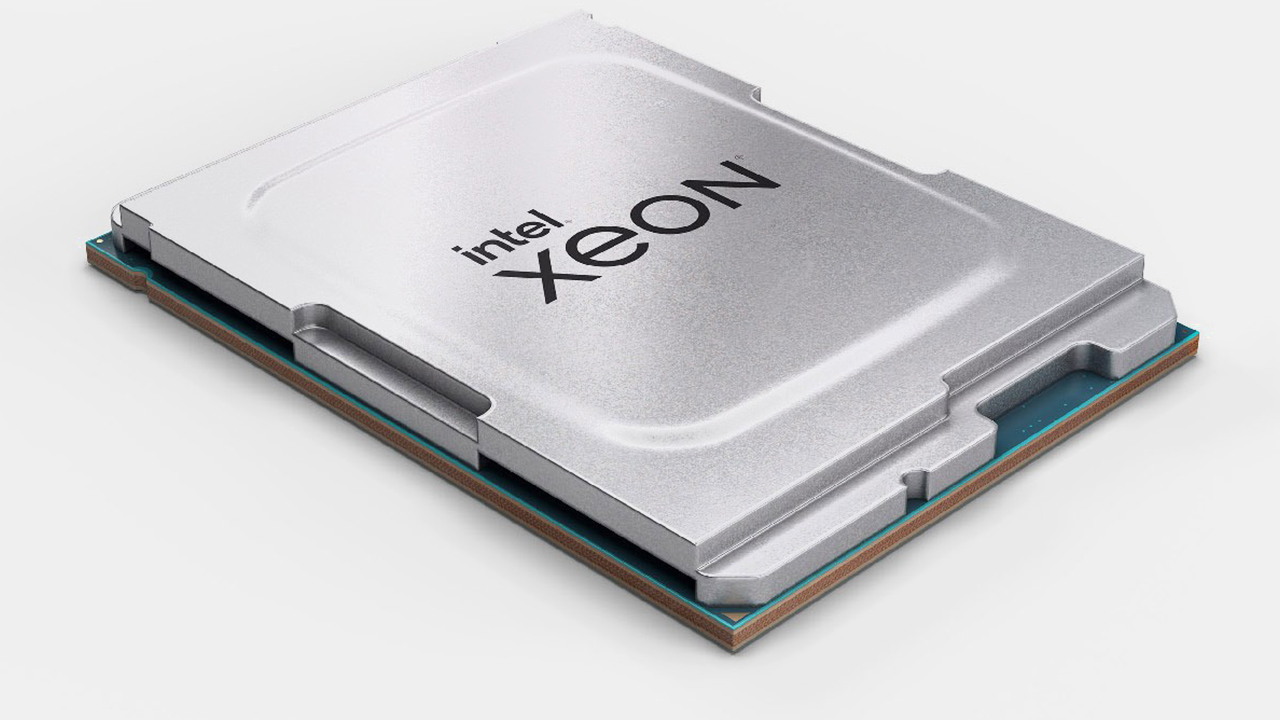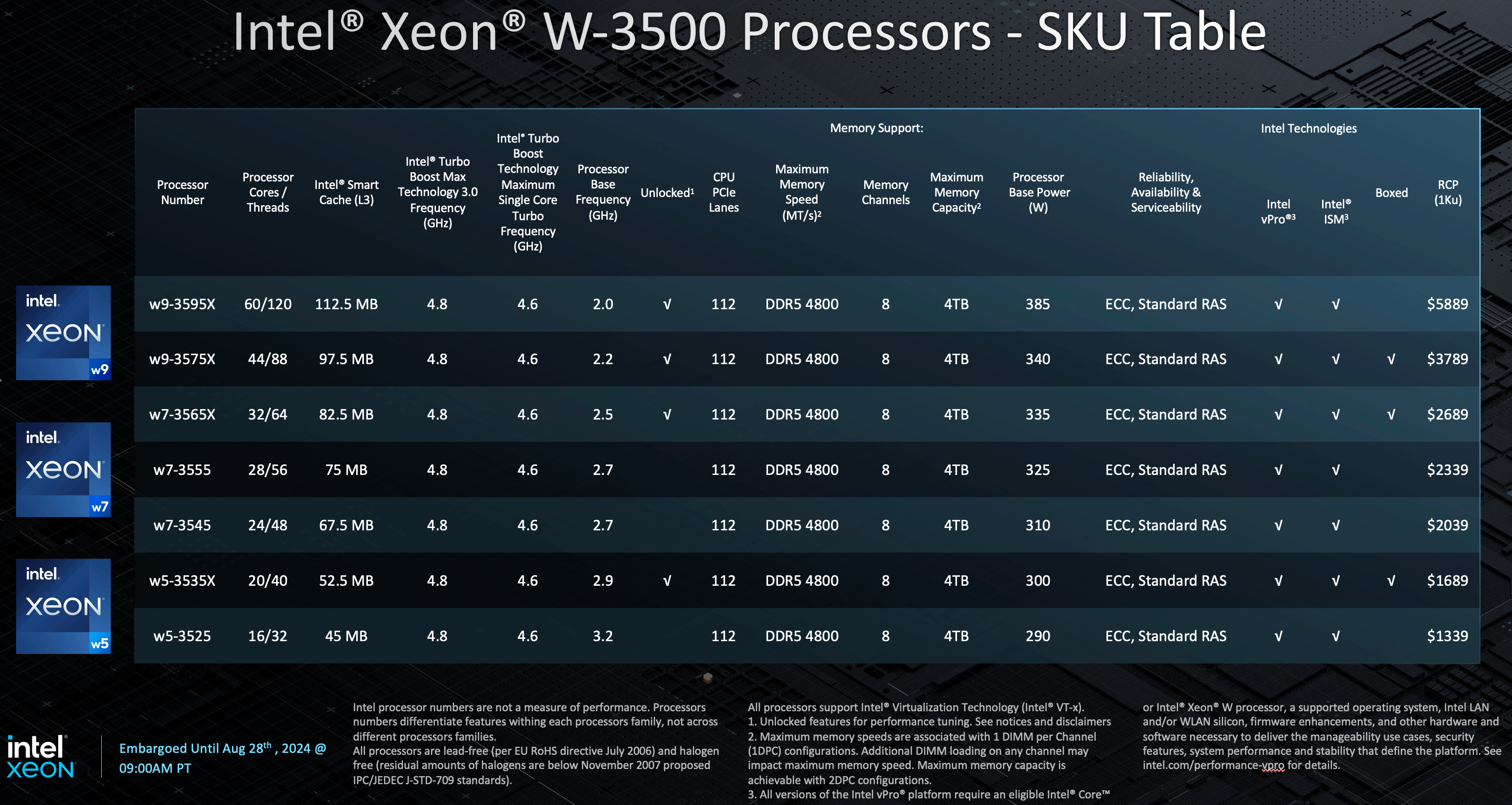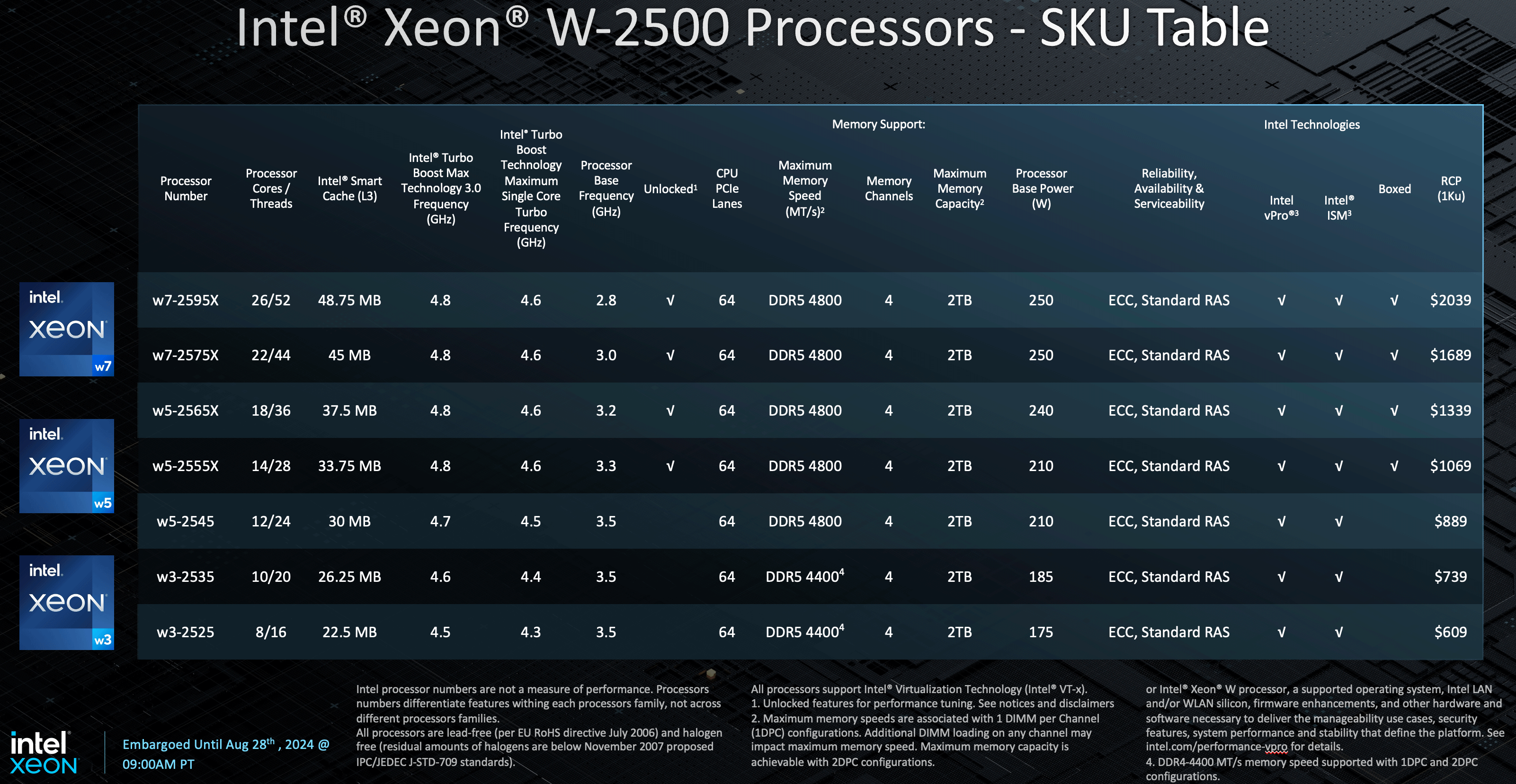Intel launches Xeon W-3500 and W-2500 processors for workstations: Up to 60 cores
At more power.

Intel today introduced its new Xeon W 'Sapphire Rapids Refresh' workstation CPUs that add clocks and cores to various models while maintaining (or even lowering) many price points. The new Xeon W-2500 and W-3500-series CPUs are drop-in compatible with Intel W790 motherboards, but higher-end models are more power hungry than their predecessors.
As the codename suggests, Intel's news Xeon W-2500 and W-3500 Series use Intel's Sapphire Rapids design, so their core count tops 60 cores. Also, they still feature four or eight memory channels for up to 2 TB or 4 TB of DDR5-4800 memory with ECC and RAS capabilities (except several models in the W-2500 range that only support DDR5-4400) as well as 64 or 112 PCIe lanes, respectively.
Regarding core count, Intel added from four to eight cores to the various Xeon W-3500 models while maintaining their price points. The range-topping Xeon W9-3595X now has 60 cores, but it has a base processor power of 385W, 35W more than its predecessor, the Xeon W9-3495X, which had 56 cores.
The less expensive Xeon W-2500 series gained two cores, so the top-of-the-line Xeon W9-2595X now features 26 cores at 250W. Again, this is 25W higher compared to the processor base power of the Xeon W9-2495X.
The new Xeon W 'Sapphire Rapids Refresh' CPU line-up will include eight processors with unlocked multipliers aimed at overclockers who also want to have workstation-grade capabilities. These include the monstrous 60-core Xeon W9-3595X, 44-core Xeon W9-9575X, 32-core Xeon W7-3565X, and 20-core Xeon W5-3535X. In the Xeon W-2500 range, unlocked CPUs include 26-core Xeon W7-2595X, 22-core Xeon W7-2575X, 18-core W5-2565X, and 14-core W5-2555X.
Keeping in mind that rather modest core count (in most cases) and clock-speed improvements, it is hard to expect Intel's Xeon W 'Sapphire Rapids Refresh' processors to offer a tangible performance boost compared to the original Xeon W 'Sapphire Rapids' CPUs. Nonetheless, all leading workstation makers — Dell, HP, Lenovo, Supermicro, Puget, and Hypertec — are set to offer machines based on the new processors. Motherboard makers will also support the new CPUs with either new W790 models or BIOS updates. For example, ASRock and Gigabyte are prepping new W790 platforms, whereas Colorful Jwipc and Maxsun are set to enter the workstation motherboard market for the first time.
When it comes to pricing, the top-of-the-range Xeon W9-3595X costs $5889 in 1K unit quantities, the same price tag as its predecessor. The Xeon W7-2595X costs $2039, a bit lower than the recommended price of its predecessor, which was $2189.
Get Tom's Hardware's best news and in-depth reviews, straight to your inbox.

Anton Shilov is a contributing writer at Tom’s Hardware. Over the past couple of decades, he has covered everything from CPUs and GPUs to supercomputers and from modern process technologies and latest fab tools to high-tech industry trends.
-
bit_user Reply
The underlined part should be W-3500.The title said:Intel launches Xeon W-2500 and W-2600 processors for workstations: Up to 60 cores -
JRStern Well gosh, mention that these are still hyperthreaded so you get 120 threads with your 60 cores.Reply
And look at the base frequency, that slows way down for the 60 core model.
Are these still all air-cooled? -
bit_user Reply
Some of the lower-TDP models can definitely be air-cooled. I've seen benchmarks where this cooler has been used for up to 300 W.JRStern said:Are these still all air-cooled?
https://noctua.at/en/nh-u14s-dx-4677
Air cooling these large CPUs is a little easier than a desktop CPU of comparable wattage, due to their larger heatspreader area. -
bit_user Reply
Good question. Some of us have wondered, as well. I have yet to find an answer.TheSecondPower said:Why is there a Sapphire Rapids Refresh when Emerald Rapids exists
One point of interest is that the P-cores in Sapphire Rapids are a little more like the ones in Raptor Lake. So, there might be less upside to doing that.
Another point of interest is that some of Emerald Rapids' gains come from reducing the number of dies (or, specifically, cross-die communication links). However, at least the lower-end Xeon W 2400 processors use a monolithic die, so the benefit of respinning those would be less. That still leaves open the question why they didn't use Emerald Rapids dies for the 3500 series... -
JRStern Reply
It's a good question but there are always issues of slightly different behaviors, yields, costs, coding, motherboards, BIOS, etc. Intel always wants to get back to their tick-tock, +++ systems.TheSecondPower said:Why is there a Sapphire Rapids Refresh when Emerald Rapids exists? -
HideOut Reply
And none of that changed so why would they mention it?JRStern said:Well gosh, mention that these are still hyperthreaded so you get 120 threads with your 60 cores.
And look at the base frequency, that slows way down for the 60 core model.
Are these still all air-cooled? -
thestryker It's still surprising to me that these are launching and exist really. I suppose it must come down to OEM contacts and binning in the end. Though there's of course EMR which scales up to 32c on MCC and 64c on XCC.Reply
The only thing I can think of is that they didn't develop a 4ch memory controller version of EMR though that doesn't explain why the 3500 series isn't EMR. Perhaps it's just a matter of wanting to emphasize scalable with EMR and GNR workstation parts will be coming earlier than expected.
They didn't seem to adjust tray pricing which means they're more expensive than the 24c TR and cheaper than the TR Pro. -
endocine "but higher-end models are more power hungry than their predecessors."Reply
That really sums up intel lately

